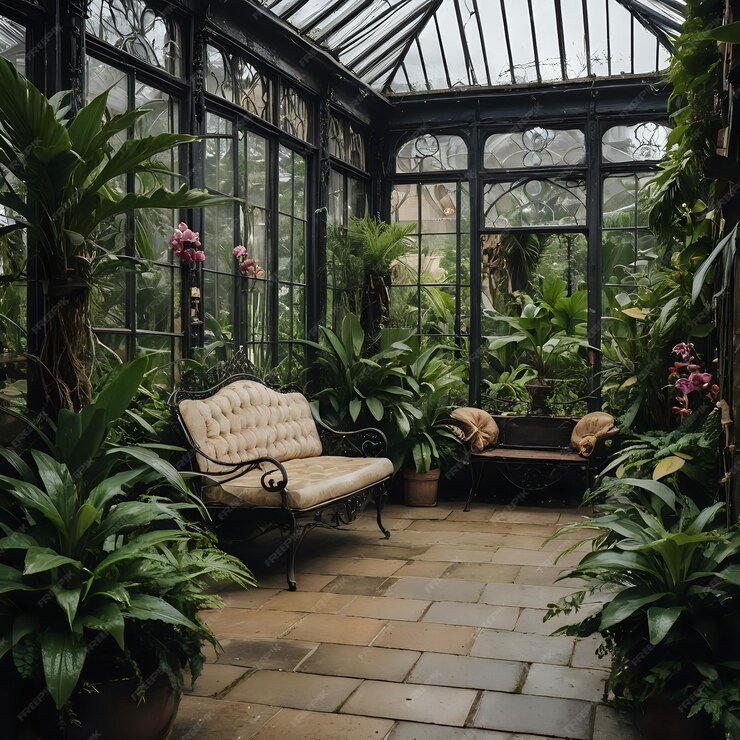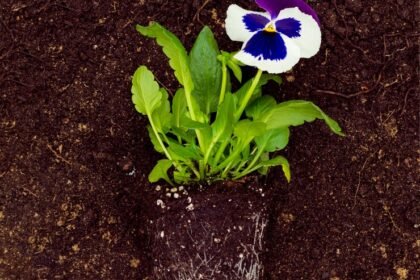improve Your Quality of Life
These ideas for indoor gardens show off how simple it is to add some greenery—or plenty of it—to your homes and create the ideal indoor-outdoor space.

Improve Your Quality of Life
These indoor garden ideas demonstrate that having a little garden at home and living with plants is totally feasible regardless of the size, design, or location of your house. The only thing left to do is choose the appropriate variety.
Also Reading: plants for ground cover. We list 20 of the best.
1. Select plants native to the area and climate

Improve Your Quality of Life
Consider bringing in minimal care indoor gardening plants to entirely change the atmosphere and design of your house. You’ll be amazed at how the temperature and atmosphere of the space drop.
According to Guto Requena of Estudio Guto Requena, “a long-suspended flower box crosses all the integrated environments and draws, along with the floor vases and pendants, a private biome.” The ability of the plants to provide a particular microclimate may lower high temperatures and enhance air quality. The home management system at The Terrace Apartment may be operated locally with smart keypads or voice commands, or remotely with mobile devices. This gives you the flexibility to build up various situations, such as workstations, parties, or movie theaters, in addition to daily operations. All of the following are automated: doors, curtains, furniture, audio and video, lighting, and irrigation.
2. USE PLANTS TO DECORATE A WINDING STAIRCASE

Improve Your Quality of Life
In case you’re seeking for novel ideas for decorating a staircase (other from the customary paint schemes and gallery walls), using plants is a fantastic strategy to get a really striking appearance. Select the quickest-growing indoor plants and use them to highlight railings so that the staircase becomes the house’s main attraction.
According to Alice Dobie, the creator of Botanica Studio, “many plant species are epiphytic, meaning they climb on other plants and trees in their natural habitat.” After these plants are in our houses, they often need support, which is why a lot of them are sold with moss poles and frames. This support may be provided by the plants climbing walls, staircases, window frames, or even furniture. Plants are ‘choose your own adventure’ experiences; they may climb, trail, hang, grow tall, remain little, or simply sit there and develop thicker foliage.
3. Cultivate a kitchen herb garden

Improve Your Quality of Life
Not sure which herbs to cultivate in your kitchen? Experts advise choosing ones that need very little upkeep.
According to Whitney Bromberg Hawkings, the creator of FLOWERBX, “mint is one of my favorite, easiest herbs to grow. It’s also great for fresh mint teas on summer mornings.” Mint comes in a variety of kinds, including spearmint, peppermint, and even mojito mint. “Thyme, basil, and rosemary are some additional adaptable options that can be used as garnishes, in shrubs, or in syrups.”
4. SELECT INDOOR STARTING PLANTS

Improve Your Quality of Life
Before beginning an indoor garden or an indoor jungle, consider the following whether you’re remodeling your space or using plants as décor. “Don’t feel like you have to have them all at once,” advises Botanica Studio founder Alice Dobie. With every one you purchase, take your time to determine its proper location and frequency of watering. After achieving success with one or two, you’ll be motivated to keep adding to your collection.
Start small and with the simplest to care for greens when it comes to apartment gardening, especially for beginners.
According to Darryl Cheng, the creator of The House Plant Journal, “you need to be realistic about how many plants you can maintain by your windows — it’s not as easy as “everything will grow beautifully if only I care for it right.” Choose plants that will thrive in your current lighting conditions. The adage “the right plant for the right place” applies to outdoor gardening. This principle still applies when growing plants in movable pots, and you must acknowledge that the size of your windows is the primary restriction on healthy development.
5. USE CONTRASTING WALL COLORS TO MAKE GREENERY POP

Improve Your Quality of Life
This beautifully designed room offers endless ideas, but their use of indoor plants is particularly clever. We like how natural the houseplants employed in this space seem. Consider indoor fruit plants that will contrast with your interior décor if you want to bring additional color to your house.
According to Kat Aul Cervoni, “Think about using a staghorn fern to contrast with wall colors.” It has exquisite, distinctive greenery that may be purchased as wall-mountable plaques. These plants need steady rainfall and thrive in higher humidity levels. They’re a nice option for someone who has some expertise taking care of indoor plants (but they’re not low-maintenance or necessarily a suitable choice for beginners).
6. IN A CLIMBING PLANT, DITCH WALLPAPER AND COVER A WALL

Improve Your Quality of Life
When it comes to wallpaper for your dining room, there are times when actual plants will do. With delicate Creeping Figs climbing up the walls and rich flora planted at the base, Studio Montemayor’s design has an actual border extending along one wall. It gives this modern area an unusual, almost mystical atmosphere.
Regina Perez, the founder of Studio Montemayor, says, “We wanted to take advantage of the abundant natural light and create a stunning but unexpected backdrop for the dining room.” We were able to improve the indoor/outdoor eating experience by adding Creeping Fig to the rear wall, particularly when the big floor-to-ceiling sliding glass doors are completely open. The kitchen, dining area, and living rooms are all open to one another on the ground level, so this sensation permeates the whole area and emphasizes the greatest aspect of living in Los Angeles: the weather.
7. USE SHELVING TO IMPROVE A LIVING WALL.

Improve Your Quality of Life
Although they may be costly to construct and aren’t appropriate for every house, living walls are a striking way to create an indoor zen garden. Therefore, using shelves to get a similar design is a great (and more low maintenance) option.
“Consider pothos; it’s a trailing plant that requires little maintenance and looks great in a wall-mounted planter or nestled into a bookshelf,” suggests Kat. This plant is excellent for walls and comes in solid green, solid chartreuse, or specially variegated versions. Another trailing plant that is simple to maintain is the spider plant.
Choose designs with wide spaces between the shelves to accommodate bigger plants, and choose plants that take up as much room as possible. Asparagus ferns, Japanese ferns, Boston ferns, and maidenhair ferns are excellent choices.
8. INTEGRATE OUTDOORS AND IN
The inside and exterior of the Mork-Ulnes Architects-designed home flow together seamlessly. The inside plants give the space a more upscale appearance and cozy atmosphere.
“[The homeowners] thrive on continuously generating new ideas,” says Mork-Ulnes Architects’ Casper Mork-Ulnes. They’ve expanded their realm with this new garden pavilion, adding even more marvel. They wanted a dining area and kitchen that they could use both indoors and outside throughout the year. The intention was to allow the surrounding scenery to permeate the structure.
Take inspiration from this serene area and replicate the atmosphere by placing little clusters of houseplants all around a room so that you are walking amid greenery the whole time.
9. ADD SOME HEIGHT TO SMALLER POTTED PLANTS

Improve Your Quality of Life
Adding fashionable pots for an indoor garden will give your house a whole new look. Plants that will contribute varying heights, sizes, and textures should be grouped together to make even a tiny setting seem impressive. Because they are so distinct from one another, Calatheas, Peperomia, and snake plants all look amazing together.
“Think about Bird of Paradise; it’s a medium-to-large indoor tree that branches outward into a ‘V’ shape, narrowing at the base,” suggests Kat. They like bright to medium-indirect light. A ‘fountain’-like impression is created at the top of the slender stem and base of the Kentia palm by outward-extending branches. A peculiar tropical plant, Dracaena Marginata has extremely slender, sometimes curved stems or trunks topped with sprays of long, thin pompoms of leaf. The multi-stem alternatives are fantastic since they provide the optimum dimension without using a lot of room. These need little maintenance, thrive in bright, indirect light, and come in a variety of striking colors, some of which have foliage that is somewhat pink.
10. USE STRUCTURAL PLANTS TO COMPARE SOFT TEXTURE

Improve Your Quality of Life
The ideal plants for an interior zen garden are indoor trees and bigger, more striking greens. Designer Crystal Sinclair’s living room is a stunning combination of purple and green, and we like how the area’s gentle curves complement the architectural plants.
However, which trees work best in pots to achieve this effect? “Trees are typically used to style spaces in magazines, but they are not permanent fixtures,” Crystal explains. Nevertheless, despite my best efforts, I haven’t been able to locate many clients that like having a tree inside, even with good lighting. Both ficus and lemon trees are excellent choices. My favorite plant, the agave, and my plumeria both need a lot of light to thrive in my home.
11. GROUP HOUSE PLANTS TOGETHER FOR A JUNGLE-LIKE EFFECT

Improve Your Quality of Life
Treating an interior contemporary garden should be approached similarly to how you would any other area of your house. “You want to start with scale when creating an indoor garden; not every room has to be filled with plants,” advises Alice. ‘A gorgeous fuzzy Asparagus Fern, for example, providing some excellent texture to a desk or a cascading Philodendron just beside a window would bring interest to a tiny room’ may often create the impression that the area is ‘planty’ in a smaller space.
It’s great to adhere to the rule of three when creating a bigger display, advises Alice. often placing a bigger plant in a corner or off to the side of the room, followed by a medium-sized plant directly in front of it and a smaller plant, arranged in the shape of a triangle on the floor, to cover the larger plant’s container. In this manner, each plant’s leaves produces a thick patch of green, which is pleasing to the sight and makes a beautiful feature. Plants may transpire together and maintain their own humidity by grouping together, which has an additional advantage that keeps the plants healthy.
12. Cultivate a tree in your kitchen.

Improve Your Quality of Life
An olive tree’s organic shape contrasts well with the kitchen’s monotone, clean lines, and unexpected design element. It softens the space and adds something unexpected.
Consider the quantity of water a tree requires while choosing the finest indoor trees and caring for them. According to Kat, “this will depend on the variety, environment, and size of the pot.” As a general guideline, however, you should water the tree until some of the excess runs out of the base (that way, you’ll know it’s reached the deepest parts of the potting soil). Once again, remember to empty any saucers that could be sitting below the base of your pot of water!
13. HANG PLANTS AT DIFFERENT LEVELS

Improve Your Quality of Life
An simpler way to get that jungle vibe within a space is to arrange plants at varying heights. According to Patch Plant Doctor Richard Cheshire, “to use the full height of the room” is a key piece of advice when hanging plants inside. Plants that trail, such as Devil’s Ivy, might find a home on bookshelves or mantelpieces. Alternatively, embrace hanging plants like shingle plants or satin pothos that are draped from the ceiling. They seem better the longer they grow.
“Establish balance between plants, receptacles, and the surrounding area,” advises Darryl. A flourishing plant indicates that the environment is favorable to life and energy. Make sure the plants are placed in areas where they will grow well, but also let the pots and containers blend in with your décor. Select Monstera deliciosa (staked to a trellis), Dieffenbachias, Rubber plants, Fiddle Leaf fig (if you have great light), Snake plants, or Dracaena marginatas for taller structural plants. Additionally, for long-trailing plants, consider Hoya carnosa (for greater light settings), string of hearts, pothos, and heart-leaf philodendron (for compact spaces).
14. POSITION AN INDOOR GARDEN TO CREATE AN INSPIRING VIEW

Improve Your Quality of Life
Since we all know how beneficial it is to have plants about us while working, a home office is an excellent location for an indoor garden. The plants in this office are perfectly placed between the desk and the window, which lets in plenty of natural light and creates a lovely interior.
According to Emilie, “we mixed pot sizes and plant shapes, leaf scale, and pot styles into the client’s display of books and art” while using potted plants as decorations in this office wall display. “The green sculptures that the plants create add texture and interest.”
Emilie continues, “Remember to vary the variety of plants displayed in a room.” Combining ferns, palms, and cactus creates an eye-catching visual narrative. It’s crucial to verify the amount of sunshine in the area where you want to put your indoor garden. Before making a purchase, check sure the lighting is ideal for the plants you want to buy. Each plant has certain environmental needs to survive.
WHICH ARE THE BEST SELECTIONS TO START AN INTERIOR GARDEN?
(Improve Your Quality of Life)
“The easy families—Pothos, Sansevierias, Hoyas, and Philodendrons—are a good place to start if you’re new to indoor gardening,” advises Alice. “All plants function best when they are kept alive!” Thus, as a good beginning point for your indoor garden, choose plants that are easy to maintain so they may flourish and look great.
“Purchasing or acquiring smaller plants or plant ‘pups’—the ‘babies’ you get from Aloe Vera and Spiderplants—is another way to start small,” advises Alice. Everything will grow and develop given enough time and favorable circumstances. Sometimes all you need is one or two statement plants in a bigger area. As a result, you should look for plant species like Monsteras, Strelitzias, and Palms that have the capacity to grow enormous and wild.
“My recommendation is to begin with plants that are simple to grow,” advises Philip Oostenbrink, the author of The Jungle Garden. ‘Observe Aspidistra, Monstera, Spiderplants, etc. Place leaves that contrast with one another in order to observe plant combinations. Thus, a big, striking leaf is placed next to a smaller, more delicate one.
Any house might have plant displays; all you need to do is change the plants according to the amount of light. A few five plants arranged in a display may create the illusion of a jungle. In addition to frequent feeding, watering is crucial. It would be simpler for novices if your plants all required about the same amount of watering.
CAN A GARDEN BEGINNING INSIDE?
Indeed! According to Alice, “even self-proclaimed ‘plant killers’ can start caring for and growing indoor plants.” “The plants we keep in our homes come from all over the world, from warm deserts to subtropical regions. As a result, you should find out where your plant grows naturally and try to mimic those conditions as much as you can.”
“Calatheas, for instance, are an important part of the prayer plant family and are well-known for their exquisitely patterned leaves. However, they are native to South American high-humidity forests and would normally be found nestled on the jungle floor beneath numerous layers of dense tree cover,” explains Alice. This means that in our homes, they need indirect light and a warm, moist atmosphere, which makes them perfect for kitchen or bathroom plants—or any other space where a water source delivers moisture into the atmosphere.
According to Alice, “hot, dry desert environments like the western continental USA and North and South Africa are home to cacti and succulents.” As a result, they like conditions that other plants dislike, such as intense sunlight and dry air, and they can withstand a lower temperature. Our houses’ ideal environments include south-facing windowsills and cozy conservatories.
AN INDOOR GARDEN: HOW DO YOU CARE FOR IT?
“Care is easy and can even be therapeutic once you have a good foundation of light and acquire suitable plants,” explains Darryl. “Daily appreciation of your plants will let you to determine if any need insect control, cleaning, or irrigation. There are only three distinct indications to water, therefore use your sense of touch to determine when to do so:
Water succulents and other plants when the soil is dry, ensuring equal moisture levels for tropical leafy plants, ferns, and begonias.
I never need to “keep track” of watering when I use these techniques; all I have to do is look or feel the soil.





